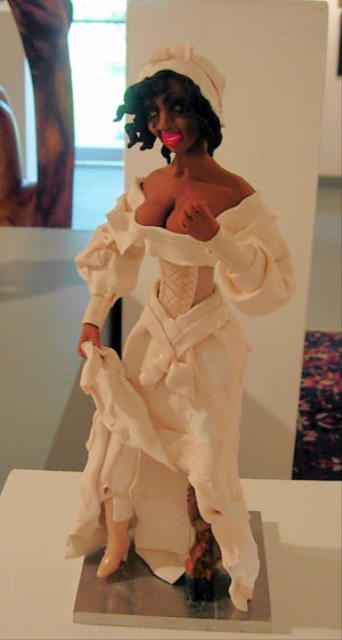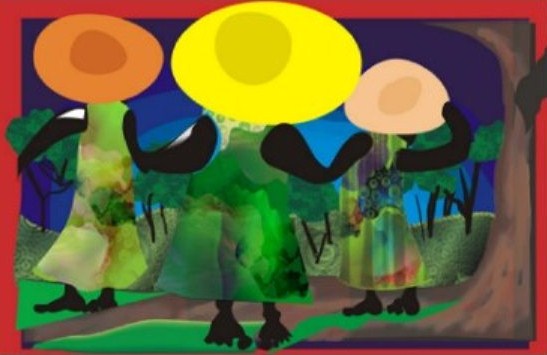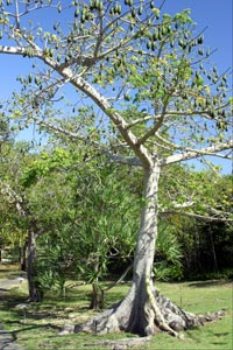|
Origins of Folklore in Trinidad and
Tobago
Parents, aunts,
uncles, grandparents or older cousins would take much delight in telling the
younger ones stories. The “jumbie” or invisible, superstitious, mischievous evil
spirits that roam both day and night and Anansi or the spider folklore
storyteller, these were usually hair-raising, heart-pumping tales of scary
creatures and terrifying encounters with the supernatural and other make-believe
mythological characters. Predominantly of African origin, with French / Patois,
Spanish, English and Indian influences.
Folklore validates
several aspects of customs and validates its rituals and foundations. It also
offers rationalisations when foundations and
principles are questioned. Folklore acts as a controlling aspect and can tell
the history of a people, along with dangers and how to avert them. They are ugly
and fearsome. Many of the supernatural folklore characters are identical with
those of African deities. It is exceedingly complicated to draw a line between
the stern religious elements and what may be described as traditions.
Nevertheless in the African tradition, stories were meant to instill values in
the children.
Trinis are well known
for their unique knack for storytelling and there is an abundance of mythical
folklore and folktales that have been handed down over the years, all routed in
the islands’ rich culture.
Lies or excuses are
often referred to as “Nanci stories” after Anansi).
In Trinidad, the
popular folklore characters or “jumbies” are as follows:
La Diablesse or Lajables, the Devil Woman, roams at night.
She has eyes like burning coals and a face resembling that of a corpse, but
hides it under a beautiful wide-brimmed hat and a veil over her face. She is
dressed exquisitely in a blouse with puffy sleeves and long, petticoated,
skirts. She has one cloven foot, which she tries to hide under her long skirts.
She turns up at village dances, where she is immediately disliked by the women
present, but she utterly charms the men and then asks one of them to take her
home. He follows her, totally under her spell. She leads him deep into the woods
and then suddenly she disappears. Unable to find his way home, the poor fellow
stumbles around in the dark wood until he either falls into a ravine or a river
to his death or gets attacked by wild hogs.
Old people talk: If you feel
you may encounter a La Diablesse on your way home, take off all your clothes,
turn them inside out and put them on again, and this will surely protect you
from a La Diablesse.

The soucouyant or soucriant, derived from the French verb sucer
– to suck is not also found in Dominican and Guadeloupean folklore, and also
known as Ole-Higue or Loogaroo in other Caribbean folklore,
is a creature equivalent of a vampire that lives by day as
an old woman at the end of the village. By night, however, she strips off her
wrinkled skin, puts it in a mortar and flies in the shape of a
fireball
through the darkness, looking for a victim. Still in the shape of a fireball,
the soucouyant enters the home of her victim through the keyhole or any crack or
crevice. Soucouyants suck the blood of people from their arms, legs and other
soft parts while they sleep. If the soucouyant draws out too much blood from her
victim, it is believed that the victim will die and become a soucouyant herself,
or else perish entirely, leaving her killer to assume her skin. The soucouyant
practices witchcraft, voodoo, and black magic. Soucouyants trade the blood of
their victims for evil powers with Bazil the demon who resides in the silk
cotton tree. To expose a
soucouyant, one should heap rice around the house or at the village cross roads
as the creature will be obligated to gather every grain, grain by grain (an
almost imposible task to do before dawn) thus being caught in the
act. In
order to destroy the soucouyant, coarse salt must be placed in the mortar
containing the soucouyant's skin. She then cannot put the skin back on and will
perish.
Old people talk: If you wish to discover who
the Soucouyant in your village is empty one hundred poundss of rice at the
village crossroads where she will be compelled to pick them up, one grain at a
time - that is how you'll know the Soucouyant.
In
Trinidad, if somebody walks around with a "hicky" (soukie) on his neck, he may
get remarks from his friends like: " Eh, Eh, Soucoyant suck yuh or wha
?”
Douen (pronounced Dwen) are considered to be the ‘lost
souls’ of children that were not baptised or
christened before death. It is
said that they are destined to wander the earth eternally while practicing their
collection of pranks. Neither male nor female, douens live in the forest, swamps
and rivers in Trinidad and Tobago. Their manifestation
is that of a naked child never growing more than two or three feet in height.
They wear a large floppy straw hat and have an entirely undistinguished face
with the exception of a small mouth. The one characteristic that allows them to
be recognised as douens are their feet, which are turned backwards with the heel
facing forward. Douens roam the land in the pursuit of children that are not yet
baptised, or christened in anticipation of luring them away deep into
the woods until they are lost. They charm the children when the moon is full and
have a mesmerising whooping sound. Children who play with a douen may consider
them to be a regular child while the douen slowly but surely leads the child
farther and farther away from the protection of home. Some children may be found
the next morning or not found at all. Douens also have been known to come to
people’s houses crying and whimpering for the love of a mother. They feed off
cultivated gardens and seem to have a bizarre fondness for water crabs. Often
thought to be evil spirits and malevolent modest creature’s douens do have a
good natured side. They have been known to be of assistance to Papa
Bois in
the forest when an animal is trapped and injured by imitating animal calls to
throw hunters off track. To avert the douens from calling your children into the
forest it is said that you should never call a child’s name in open places for
the douens will then in turn call the child’s name to attract them away into the
forest never to return. There have been actual reports of douen encounters from
children in rural areas of Trinidad such as Piparo, Penal and
Barrakpore.
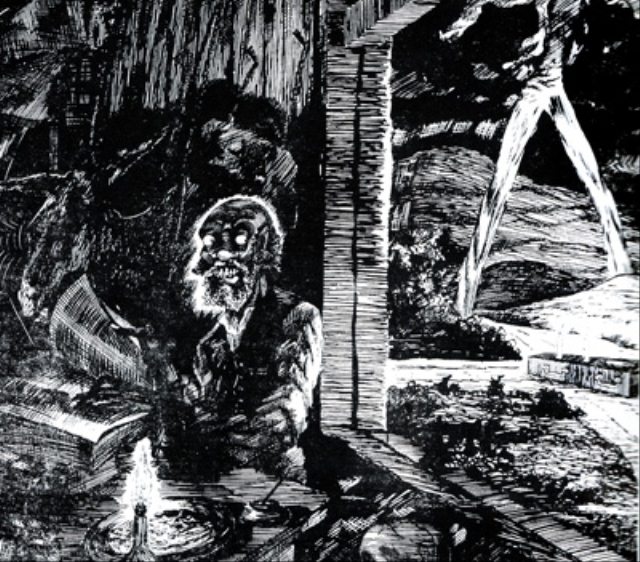
The Lagahoo or La Gahoo from the French
loup-garou meaning werewolf is a
mythical shape-shifting monster, said to often take the form of a
centaur.
It is cousin to the French loup-garou and the Germanic
werewolf, yet not restricted
to the form of a wolf. It seems like a normal human by day, but this creature
takes on the form of a man with no head, who roams the night with a wooden
coffin on his neck. On top of the coffin are three lighted candles and the long
loose end of a heavy iron chain, noosed around his waist, trails behind him.
Often, it is seen with chains around its neck, which change size. One appendage
is said to be turned backwards. It can shape-shift into various
animals, including horses, pigs or goats and is also thought to be a blood
sucker which is less than particular about its food source, making do with such
animals as cows and goats. To kill the La Gahoo one must beat the creature with
a stick which has been anointed with holy water and holy oil for nine days.
While beating the demon, it changes into other beasts such as a snarling dog, a
wild bull and thunderous waves of water and finally will disappear into a
mist.
Old
people talk: If you want to see a lugarhoo and not be seen by it, take some
yampee from the corner of a dog's eye, put it in your eye and peep out of a key
hole at midnight.
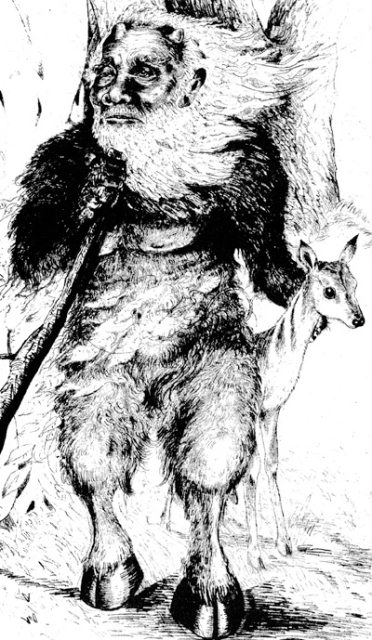
Papa Bois (otherwise known as "Maître Bois," meaning master of the woods or
"Daddy Bouchon" meaning hairy man), a French patois word for "father wood" or "father of the forest" is a popular
fictional folklore character of Trinidad
and Tobago. Often called the "keeper of the forest", he is thought of as the
protector of the forests and their flora and fauna.
His appearance is thought to be that of a short, old man of
African descent with cloven hooves (or at least his left leg ends in a large hoof) and a beard of
leaves, who, despite his age sports strong muscles and can run faster than a deer. His body is completely covered with
hair like that of a donkey and small horns sprout from his forehead, he is known
to carry a hollowed-out bull's horn which he uses to warn the animals of hunters' approach. He is also known to have the power of metamorphosis and is commonly thought to transform himself into a deer, luring hunters deep into the forest and getting them lost. Much
like his female counterpart, Mama
Dlo.
It is believed that if one meets Papa Bois, one must be polite and
refrain from staring at his hooves, and say a polite greeting to him. For example, "Bon jour, vieux Papa" meaning, "Good day, old
father."
Mama
Glow
Mama
Glow or "Mama Dlo" or "Mama Dglo" whose name is derived from the French "maman
de l' eau" meaning mother of the water is one of the lesser known personalities
of Trinidad and Tobago folklore. A half woman, half snake with long flowing hair
which she combs constantly. Her upper torso is a naked, beautiful woman, the
lower part coils into a large form of an anaconda snake that is hidden beneath
the water. She is sometimes thought to be the lover of Papa Bois and old hunters
tell stories of coming upon them in the 'High Woods'. They also tell of hearing
a loud, cracking sound which is said to be the sound made by her tail as she
snaps it on the surface of a mountain pool or a still lagoon. Mortal men who
commit crimes against the forest, like burning down trees, indiscriminately
putting animals to death or fouling the rivers could find themselves married to
her for life, both this one and the one to follow. Sometimes she takes the form
of a beautiful woman singing silent songs on still afternoons, sitting at the
water's edge in the sunlight, lingering for a golden moment, a flash of green -
gone.
Old people talk: "Did
you see a fish jump?" "Yes, but it did not go back in again!" If you were to
meet Mama Dlo in the forest and wish to escape her, take off your left shoe,
turn it upside down and immediately leave the scene, walking backwards until you
reach home.
Duppies
Duppies
are ghosts that roam the earth at night. It is said that to keep duppies out of
your house you must either sprinkle salt or rice grains all around the house; as
the duppy must first count each individual grain before entering. By which time
the sun will have arisen and they must then return to the spirit world.
Jacakalantan
The
Jacakalantan is said to be a mysterious light that appears and attracts people,
misleading the unwary into desolate areas far away from their intended
destinations. And then vanishes.
Silk Cotton trees
Silk
Cotton trees are regarded with a kind of awed reverence and fear. These are huge
trees. It is reported to be very difficult to be able to find someone who will
cut down a silk cotton tree as they are said to be the home of spirits and
duppies. To cut it down is to free them to roam the earth. The Castle
of the Devil is a huge silk cotton tree growing deep in the forest in which
Bazil the demon of death was imprisoned by a carpenter. The carpenter tricked
the devil into entering the tree in which he carved seven rooms, one above the
other, into the trunk. Folklore claims that Bazil still resides in that
tree.
Witchdoctors
Witchdoctors, or as they are known locally, Obeah men, are said to
abound. It is said that you can visit one to have any manner of spell performed
to grant your desires. It is thought that curses are powerful and can be cast by
anyone. Even your neighbour may put the evil eye or MalYeux (Maljo) on you. Any
discomfort, hardship or illness may be attributed to this. It can supposedly be
warded off by placing blue bottles around your property and by wearing bracelets
or anklets made of Jumbie beads (a little black and red bead found growing on
certain bushes.)
Tobago has its own jumbies
Gang
Gang Sara.
The
legend of Gang Gang Sara, the African witch of Golden Lane, has its origins in
the latter half of the 18th century. On a stormy night she was blown from her
home in Africa across the sea to Tobago and landed quite safely at the village
of Les Coteaux. From there she journeyed to Golden Lane in search of her family
who had long ago been transported there. She lived to a great age and is
remembered for her wisdom and kindness. She became the loving wife of Tom, whom
legend says she had known as a child in her native Africa. She lived to a great
age and is remembered for her wisdom and kindness. After her Tom had died,
wishing to return to her native land, she climbed a great silk cotton tree and
tried to fly, not knowing that she had lost the art of flight as a result of
having eaten salt. To this day the names of Tom and Sara can be seen inscribed
upon the head stones of their graves where they have lain side by side for close
upon two hundred years.
Mermaids
Mermaids
are Leviathan, great denizens of the deep. Amongst the swirling currents and
white capped blue-green waters, just where the Caribbean Sea meets the Atlantic
Ocean, close by St. Giles and near to Misty Marble Island, past Anse Gouleme and
Anse Brisant, towards the Bird of Paradise Island and down the coast past
Speyside to Fat Hog Bay, it is remembered from long ago that this was where the
mermaids came to play. Tobago mermaids are male and live in the deep, deep sea.
They mate with the fairy maids of the rivers and the secret mountain pools.
Riding upon the crest of waves, they are handsome men like kings of old or
warriors of long ago, beplumed and richly garbed. They may grant a wish,
transform mediocrity into genius and confer wealth and power. Sometimes the
water people seek relationships with mortals. Some men are particularly
attractive to the fairy maids, especially men with smooth skin.
Fairymaids
Fairymaids
are said to be beautiful with long lush hair and one tiny foot in the shape of a
deer's hoof, she may use her power to "turn" a man's head. She may steal his
shadow and leave him quite demented. In which case, accompanied by friends and
family and with the help of a "workman", he must go to the river and address the
water pleading for the restoration of his lost shadow. This done, he must leave
the water's edge and not look back. Fairymaids may be found in caves behind
waterfalls or beneath certain bridges where the river runs deep and swift. In
days gone by, they were seen near certain water wheels. To discontinue a
relationship with a fairy queen, offerings of two pairs of shoes must be made.
The first must be burnt on the beach, the fairymaid will then rise out of the
water and ask if she is to be paid for past services. The answer must be
"nothing but this pair of shoes". The second must then be thrown into the
waves.
ALL IN ALL MAKES A CHANGE FROM
BOGEYMEN AND ELVES
|
